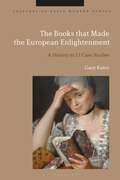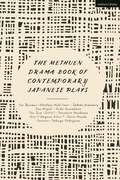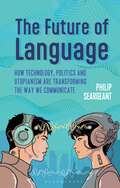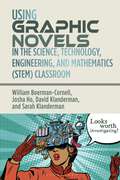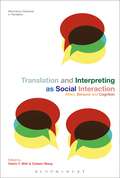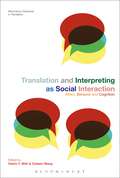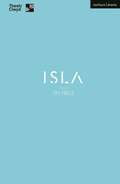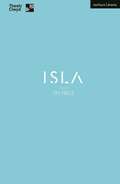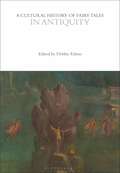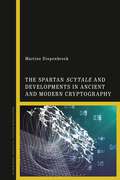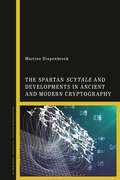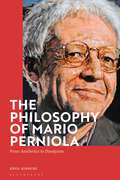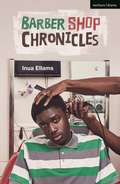- Table View
- List View
The Books that Made the European Enlightenment: A History in 12 Case Studies (Cultures of Early Modern Europe)
by Gary KatesIn contrast to traditional Enlightenment studies that focus solely on authors and ideas, Gary Kates' employs a literary lens to offer a wholly original history of the period in Europe from 1699 to 1780. Each chapter is a biography of a book which tells the story of the text from its inception through to the revolutionary era, with wider aspects of the Enlightenment era being revealed through the narrative of the book's publication and reception. Here, Kates joins new approaches to book history with more traditional intellectual history by treating authors, publishers, and readers in a balanced fashion throughout.Using a unique database of 18th-century editions representing 5,000 titles, the book looks at the multifaceted significance of bestsellers from the time. It analyses key works by Voltaire, Adam Smith, Madame de Graffigny, Jean-Jacques Rousseau and David Hume and champions the importance of a crucial innovation of the age: the rise of the 'erudite blockbuster', which for the first time in European history, helped to popularize political theory among a large portion of the middling classes. Kates also highlights how, when, and why some of these books were read in the European colonies, as well as incorporating the responses of both ordinary men and women as part of the reception histories that are so integral to the volume.
Jesus in the Victorian Novel: Reimagining Christ (New Directions in Religion and Literature)
by Jessica Ann HughesThis book tells the story of how nineteenth-century writers turned to the realist novel in order to reimagine Jesus during a century where traditional religious faith appeared increasingly untenable. Re-workings of the canonical Gospels and other projects to demythologize the story of Jesus are frequently treated as projects aiming to secularize and even discredit traditional Christian faith. The novels of Charles Kingsley, George Eliot, Eliza Lynn Linton, and Mary Augusta Ward, however, demonstrate that the work of bringing the Christian tradition of prophet, priest, and king into conversation with a rapidly changing world can at times be a form of authentic faith-even a faith that remains rooted in the Bible and historic Christianity, while simultaneously creating a space that allows traditional understandings of Jesus' identity to evolve.
Jesus in the Victorian Novel: Reimagining Christ (New Directions in Religion and Literature)
by Jessica Ann HughesThis book tells the story of how nineteenth-century writers turned to the realist novel in order to reimagine Jesus during a century where traditional religious faith appeared increasingly untenable. Re-workings of the canonical Gospels and other projects to demythologize the story of Jesus are frequently treated as projects aiming to secularize and even discredit traditional Christian faith. The novels of Charles Kingsley, George Eliot, Eliza Lynn Linton, and Mary Augusta Ward, however, demonstrate that the work of bringing the Christian tradition of prophet, priest, and king into conversation with a rapidly changing world can at times be a form of authentic faith-even a faith that remains rooted in the Bible and historic Christianity, while simultaneously creating a space that allows traditional understandings of Jesus' identity to evolve.
The Methuen Drama Book of Contemporary Japanese Plays: Bacchae-Holstein Milk Cows; One Night; Isn't Anyone Alive?; The Sun; Carcass
by Yuko Kuwabara Takuya Yokoyama Shiro Maeda Satoko Ichihara Tomohiro MaekawaPublished alongside Japan Foundation, this collection features five creative and bold plays by some of Japan's most prolific writers of contemporary theatre. Translated into English for the first time, these texts explore a wide-range of themes from dystopian ideas of the future to touching domestic tragedies. Brought together in one volume, introduced by the authors and Japan Foundation, this collection offers English language readers an unprecedented look at some of Japan's finest works of contemporary drama by writers from across the country. The plays include:Bacchae Holstein Milk Cows by Satoko Ichihara,This play takes themes of the ancient Greek tragedy Bacchae by Euripides to examine various aspects of contemporary society, from love and sex, man and woman, intermixture of different species, discrimination and abuse, to artificial insemination, criticism of anthropocentricism and more. It was the winner of the 64th Kishida Drama Award. One Night (hitoyo) by Yuko KuwabaraThe setting is a small taxi company run out of the home of its owner in a country town. One night the mother, KoharuInamura, decides to leave the home in order to protect her children from her husband's domestic violence,promising them that she will come back in 15 years. The play depicts the family's reunion after having to live withthe burden of that one night's (hitoyo) incident and how they restarted their lives after it. Isn't Anyone Alive? by Shiro MaedaThis laid back, absurdist work examines death through a goofy lens. In the play, strange urban legends abound ina university hospital where young people die one after another, all with mobile phones in their hands.The Sun by Tomohiro MaekawaDepicts young people torn apart in a near future setting where humanity has split into two forms: Nox humans who can only go out at night, and Curios, the original type of humans that can live under the sun.Carcass by Takuya YokoyamaThis play takes its name from the Japanese word for dressed carcasses of beef and pork that have been halved along the backbone for meat . It deals with the dignity of being alive as seen through the lives of workers in the meat industry based on interviews and research. It won the Japan Playwrights Association's 15th New Playwright Award in 2009.
The Methuen Drama Book of Contemporary Japanese Plays: Bacchae-Holstein Milk Cows; One Night; Isn't Anyone Alive?; The Sun; Carcass
by Yuko Kuwabara Takuya Yokoyama Shiro Maeda Satoko Ichihara Tomohiro MaekawaPublished alongside Japan Foundation, this collection features five creative and bold plays by some of Japan's most prolific writers of contemporary theatre. Translated into English for the first time, these texts explore a wide-range of themes from dystopian ideas of the future to touching domestic tragedies. Brought together in one volume, introduced by the authors and Japan Foundation, this collection offers English language readers an unprecedented look at some of Japan's finest works of contemporary drama by writers from across the country. The plays include:Bacchae Holstein Milk Cows by Satoko Ichihara,This play takes themes of the ancient Greek tragedy Bacchae by Euripides to examine various aspects of contemporary society, from love and sex, man and woman, intermixture of different species, discrimination and abuse, to artificial insemination, criticism of anthropocentricism and more. It was the winner of the 64th Kishida Drama Award. One Night (hitoyo) by Yuko KuwabaraThe setting is a small taxi company run out of the home of its owner in a country town. One night the mother, KoharuInamura, decides to leave the home in order to protect her children from her husband's domestic violence,promising them that she will come back in 15 years. The play depicts the family's reunion after having to live withthe burden of that one night's (hitoyo) incident and how they restarted their lives after it. Isn't Anyone Alive? by Shiro MaedaThis laid back, absurdist work examines death through a goofy lens. In the play, strange urban legends abound ina university hospital where young people die one after another, all with mobile phones in their hands.The Sun by Tomohiro MaekawaDepicts young people torn apart in a near future setting where humanity has split into two forms: Nox humans who can only go out at night, and Curios, the original type of humans that can live under the sun.Carcass by Takuya YokoyamaThis play takes its name from the Japanese word for dressed carcasses of beef and pork that have been halved along the backbone for meat . It deals with the dignity of being alive as seen through the lives of workers in the meat industry based on interviews and research. It won the Japan Playwrights Association's 15th New Playwright Award in 2009.
The Future of Language: How Technology, Politics and Utopianism are Transforming the Way we Communicate
by Dr Philip SeargeantWill language as we know it cease to exist? What could this mean for the way we live our lives?Shining a light on the technology currently being developed to revolutionise communication, The Future of Language distinguishes myth from reality and superstition from scientifically-based prediction as it plots out the importance of language and raises questions about its future. From the rise of artificial intelligence and speaking robots, to brain implants andcomputer-facilitated telepathy, language and communications expert Philip Seargeant surveys the development of new digital 'languages', such as emojis, animated gifs and memes, and investigates how conventions of spoken and written language are being modified by new trends in communication. From George Orwell's fictional predictions in Nineteen Eighty-Four to the very real warnings of climate activist Greta Thunberg, Seargeant explores language through time, traversing politics, religion, philosophy, literature, and of course technology, in the process. Tracing how previous eras have imagined the future of language, from the Bible to the works H. G. Wells, and from Star Wars to Star Trek, the book reveals how perfecting language and communication has always been a vital component of utopian dreams of the future. Questioning the potential ramifications of recent and future developments in communication on society and its ideals, The Future of Language is a no holds barred investigation into the state of civilisation and the impact that changes in language could have on our lives.
The Future of Language: How Technology, Politics and Utopianism are Transforming the Way we Communicate
by Dr Philip SeargeantWill language as we know it cease to exist? What could this mean for the way we live our lives?Shining a light on the technology currently being developed to revolutionise communication, The Future of Language distinguishes myth from reality and superstition from scientifically-based prediction as it plots out the importance of language and raises questions about its future. From the rise of artificial intelligence and speaking robots, to brain implants andcomputer-facilitated telepathy, language and communications expert Philip Seargeant surveys the development of new digital 'languages', such as emojis, animated gifs and memes, and investigates how conventions of spoken and written language are being modified by new trends in communication. From George Orwell's fictional predictions in Nineteen Eighty-Four to the very real warnings of climate activist Greta Thunberg, Seargeant explores language through time, traversing politics, religion, philosophy, literature, and of course technology, in the process. Tracing how previous eras have imagined the future of language, from the Bible to the works H. G. Wells, and from Star Wars to Star Trek, the book reveals how perfecting language and communication has always been a vital component of utopian dreams of the future. Questioning the potential ramifications of recent and future developments in communication on society and its ideals, The Future of Language is a no holds barred investigation into the state of civilisation and the impact that changes in language could have on our lives.
Using Graphic Novels in the STEM Classroom
by Professor William Boerman-Cornell Josha Ho Professor David Klanderman Dr Sarah KlandermanThis book provides everything STEM teachers need to use graphic novels in order to engage students, explain difficult concepts, and enrich learning. Drawing upon the latest educational research and over 60 years of combined teaching experience, the authors describe the multimodal affordances and constraints of each element of the STEM curriculum. Useful for new and seasoned teachers alike, the chapters provide practical guidance for teaching with graphic novels, with a section each for Science, Technology, Engineering, and Mathematics. An appendix provides nearly 100 short reviews of graphic novels arranged by topic, such as cryptography, evolution, computer coding, skyscraper design, nuclear physics, auto repair, meteorology, and human physiology, allowing the teacher to find multiple graphic novels to enhance almost any unit. These include graphic novel biographies of Stephen Hawking, Jane Goodall, Alan Turing, Rosalind Franklin, as well as popular titles such as T-Minus by Jim Ottaviani, Brooke Gladstone's The Influencing Machine, Theodoris Andropoulos's Who Killed Professor X, and Gene Yang's Secret Coders series.
Using Graphic Novels in the STEM Classroom
by Professor William Boerman-Cornell Josha Ho Professor David Klanderman Dr Sarah KlandermanThis book provides everything STEM teachers need to use graphic novels in order to engage students, explain difficult concepts, and enrich learning. Drawing upon the latest educational research and over 60 years of combined teaching experience, the authors describe the multimodal affordances and constraints of each element of the STEM curriculum. Useful for new and seasoned teachers alike, the chapters provide practical guidance for teaching with graphic novels, with a section each for Science, Technology, Engineering, and Mathematics. An appendix provides nearly 100 short reviews of graphic novels arranged by topic, such as cryptography, evolution, computer coding, skyscraper design, nuclear physics, auto repair, meteorology, and human physiology, allowing the teacher to find multiple graphic novels to enhance almost any unit. These include graphic novel biographies of Stephen Hawking, Jane Goodall, Alan Turing, Rosalind Franklin, as well as popular titles such as T-Minus by Jim Ottaviani, Brooke Gladstone's The Influencing Machine, Theodoris Andropoulos's Who Killed Professor X, and Gene Yang's Secret Coders series.
Translation and Interpreting as Social Interaction: Affect, Behavior and Cognition (Bloomsbury Advances in Translation)
Adopting the tripartite theory of social psychology as its theoretical framework, this book advocates that the three components of social interaction – affect, behaviour, and cognition – underpin the daily activities of translators and interpreters. In particular, it argues that the affect or emotion of translators and interpreters should not be overlooked or treated as a separate entity, but as a crucial link between their mental process (cognition) and physical process (behaviour). This central theme of the intertwining nature of the affect, behaviour and cognition of translators and interpreters is examined theoretically, empirically, and methodologically with contributions from around the world, featuring literary translation, translator training, and interpreters' practice. It is a timely contribution to the field of Translation Process Research where affect is increasingly recognised as playing a key role in translation and interpreting phenomena.
Translation and Interpreting as Social Interaction: Affect, Behavior and Cognition (Bloomsbury Advances in Translation)
by Claire Y. Shih and Caiwen WangAdopting the tripartite theory of social psychology as its theoretical framework, this book advocates that the three components of social interaction – affect, behaviour, and cognition – underpin the daily activities of translators and interpreters. In particular, it argues that the affect or emotion of translators and interpreters should not be overlooked or treated as a separate entity, but as a crucial link between their mental process (cognition) and physical process (behaviour). This central theme of the intertwining nature of the affect, behaviour and cognition of translators and interpreters is examined theoretically, empirically, and methodologically with contributions from around the world, featuring literary translation, translator training, and interpreters' practice. It is a timely contribution to the field of Translation Process Research where affect is increasingly recognised as playing a key role in translation and interpreting phenomena.
Isla (Modern Plays)
by Tim PriceDo algorithms and machine learning set us free, or trap us forever? Roger hates technology, but when his daughter gives him an Isla device for Lockdown 2020, he finds himself opening up to the virtual assistant device. What happens when the only fulfilling relationship you have is with a digital slave? Isla asks what are the costs and benefits of machine learning...and do we want the AIs to learn from us? This edition was published to coincide with the world premiere at Theatre Clwyd, in association with the Royal Court in October 2021.
Isla (Modern Plays)
by Tim PriceDo algorithms and machine learning set us free, or trap us forever? Roger hates technology, but when his daughter gives him an Isla device for Lockdown 2020, he finds himself opening up to the virtual assistant device. What happens when the only fulfilling relationship you have is with a digital slave? Isla asks what are the costs and benefits of machine learning...and do we want the AIs to learn from us? This edition was published to coincide with the world premiere at Theatre Clwyd, in association with the Royal Court in October 2021.
Bones (Plays for Young People)
by Tanika GuptaIn 2014 local historian Catherine Corless made a discovery of baby bones and skeletons in the grounds of a mother and baby home in Tuam, County Galway, Ireland. Built on the grounds of an old workhouse that operated between 1921 and 1961 the discovery threw up questions about the goings-on across this and similar institutions across Ireland. Tanika Gupta's powerful drama is loosely based on these recent and historical events, drawing inspiration from Corless' discovery.Told through the eyes of Grace and her grandchildren, Bones is a play about loss, punishment of unmarried mothers and the legacy of the demonisation of women by Church and State, where the human and reproductive rights of women are undermined.Bones premiered at the Royal Central School of Speech and Drama in 2019.Bones is published in Methuen Drama's Plays For Young People Age 16+ series which offers suitable plays for young performers at schools, youth groups and youth theatres that have each had premiere productions by young performers in the UK.
Bones (Plays for Young People)
by Tanika GuptaIn 2014 local historian Catherine Corless made a discovery of baby bones and skeletons in the grounds of a mother and baby home in Tuam, County Galway, Ireland. Built on the grounds of an old workhouse that operated between 1921 and 1961 the discovery threw up questions about the goings-on across this and similar institutions across Ireland. Tanika Gupta's powerful drama is loosely based on these recent and historical events, drawing inspiration from Corless' discovery.Told through the eyes of Grace and her grandchildren, Bones is a play about loss, punishment of unmarried mothers and the legacy of the demonisation of women by Church and State, where the human and reproductive rights of women are undermined.Bones premiered at the Royal Central School of Speech and Drama in 2019.Bones is published in Methuen Drama's Plays For Young People Age 16+ series which offers suitable plays for young performers at schools, youth groups and youth theatres that have each had premiere productions by young performers in the UK.
A Cultural History of Fairy Tales in Antiquity (The Cultural Histories Series)
How have fairy tales from around the world changed over the centuries? What do they tell us about different cultures and societies? Spanning chronologically from the third millennium BCE through to the seventh century CE and beyond, and geographically from the Mediterranean to the Near East and Asia, this book explores the earliest known evidence of familiar folk tales and fairy tales in the ancient world.Drawing on sources including the Rig Veda, the Epic of Gilgamesh, the Old Testament, the Westcar Papyrus, and the Odyssey, this volume ranges from epic poetry to drama, to fables and proverbs, and from ancient histories to novels.Scholars in Classics, Anthropology, Folklore, and Asian Studies examine the dissemination, adaptation, and cross-cultural interactions of early forms of folk tales, providing new insights into how they functioned and circulated across different societies.An essential resource for scholars and students of ancient literature, history, and cultural studies, this book explores topics including: forms of the marvelous, gender and sexuality, monsters and the monstrous, the significance of spaces, socialization and moral messaging, and the uses and abuses of power.
The Spartan Scytale and Developments in Ancient and Modern Cryptography
by Dr Martine DiepenbroekThis book offers a comprehensive review and reassessment of the classical sources describing the cryptographic Spartan device known as the scytale. Challenging the view promoted by modern historians of cryptography which look at the scytale as a simple and impractical 'stick', Diepenbroek argues for the scytale's deserved status as a vehicle for secret communication in the ancient world. By way of comparison, Diepenbroek demonstrates that the cryptographic principles employed in the Spartan scytale show an encryption and coding system that is no less complex than some 20th-century transposition ciphers. The result is that, contrary to the accepted point of view, scytale encryption is as complex and secure as other known ancient ciphers. Drawing on salient comparisons with a selection of modern transposition ciphers (and their historical predecessors), the reader is provided with a detailed overview and analysis of the surviving classical sources that similarly reveal the potential of the scytale as an actual cryptographic and steganographic tool in ancient Sparta in order to illustrate the relative sophistication of the Spartan scytale as a practical device for secret communication. This helps to establish the conceptual basis that the scytale would, in theory, have offered its ancient users a secure method for secret communication over long distances.
The Spartan Scytale and Developments in Ancient and Modern Cryptography
by Dr Martine DiepenbroekThis book offers a comprehensive review and reassessment of the classical sources describing the cryptographic Spartan device known as the scytale. Challenging the view promoted by modern historians of cryptography which look at the scytale as a simple and impractical 'stick', Diepenbroek argues for the scytale's deserved status as a vehicle for secret communication in the ancient world. By way of comparison, Diepenbroek demonstrates that the cryptographic principles employed in the Spartan scytale show an encryption and coding system that is no less complex than some 20th-century transposition ciphers. The result is that, contrary to the accepted point of view, scytale encryption is as complex and secure as other known ancient ciphers. Drawing on salient comparisons with a selection of modern transposition ciphers (and their historical predecessors), the reader is provided with a detailed overview and analysis of the surviving classical sources that similarly reveal the potential of the scytale as an actual cryptographic and steganographic tool in ancient Sparta in order to illustrate the relative sophistication of the Spartan scytale as a practical device for secret communication. This helps to establish the conceptual basis that the scytale would, in theory, have offered its ancient users a secure method for secret communication over long distances.
Exploring Ecolinguistics: Ecological Principles and Narrative Practices (Bloomsbury Advances in Ecolinguistics)
by Douglas Mark PontonContributing to the rapidly emerging field of ecolinguistics, this book explores the role of language in mediating and determining our relationship with nature and in shaping attitudes and social practices in environmental areas. In doing so, it maps out research pathways for informed ecological debate that concerns both the planet and the discipline.The book centres on two case studies. The first is a nature reserve near Siracusa in Sicily run by Fabio Cilea, where flamingos have begun to breed despite the devastation of the nearby coastline by one of the largest petro-chemical plants in Europe. The second is High Ash farm, a small farm near Norwich, UK. Farmer, Chris Skinner, is a passionate naturalist who for 30 years has presented a programme on BBC Radio Norfolk. Through analysing the discourse of both Skinner and Cilea, the book explores what it can reveal about the underlying environmental visions that sustain them. Together with the discourse of other engaged ecological figures, a picture emerges of the connections that exist between our beliefs/attitudes, language and the natural world.Presenting a framework for analysing environmental discourse from a primarily positivist standpoint, the book draws attention to the discourses that underline social practices felt to be useful, necessary and beneficial in these moments of environmental crisis. Although these contexts are European, the methodologies applied, as well as the ecological and linguistic issues dealt with, are universal, clarifying the relationship between social practices and language itself, viewed in the book as an ecosystem that is also in need of loving attention.
Exploring Ecolinguistics: Ecological Principles and Narrative Practices (Bloomsbury Advances in Ecolinguistics)
by Douglas Mark PontonContributing to the rapidly emerging field of ecolinguistics, this book explores the role of language in mediating and determining our relationship with nature and in shaping attitudes and social practices in environmental areas. In doing so, it maps out research pathways for informed ecological debate that concerns both the planet and the discipline.The book centres on two case studies. The first is a nature reserve near Siracusa in Sicily run by Fabio Cilea, where flamingos have begun to breed despite the devastation of the nearby coastline by one of the largest petro-chemical plants in Europe. The second is High Ash farm, a small farm near Norwich, UK. Farmer, Chris Skinner, is a passionate naturalist who for 30 years has presented a programme on BBC Radio Norfolk. Through analysing the discourse of both Skinner and Cilea, the book explores what it can reveal about the underlying environmental visions that sustain them. Together with the discourse of other engaged ecological figures, a picture emerges of the connections that exist between our beliefs/attitudes, language and the natural world.Presenting a framework for analysing environmental discourse from a primarily positivist standpoint, the book draws attention to the discourses that underline social practices felt to be useful, necessary and beneficial in these moments of environmental crisis. Although these contexts are European, the methodologies applied, as well as the ecological and linguistic issues dealt with, are universal, clarifying the relationship between social practices and language itself, viewed in the book as an ecosystem that is also in need of loving attention.
The Philosophy of Mario Perniola: From Aesthetics to Dandyism
by Enea BianchiEnea Bianchi provides the first in-depth introduction to the pioneering thought of 20th-century Italian philosopher, Mario Perniola. Examining Perniola's entire oeuvre, this book also pushes his philosophy into new directions by investigating the connection between his aesthetics and the philosophical underpinnings of dandyism. Rich in influences, from ancient Stoicism to Roman ritualism, Baroque literature and avant-garde revolutionary movements, Perniola's philosophy is wide-ranging. This book highlights and explores numerous notions pivotal to understanding Perniola's thought, including: the “sex appeal of the inorganic”, the “enigma”, “strategic beauty” and the “artistic shadow”. Combining these concepts with three exemplar dandies – George Brummell, Charles Baudelaire and Oscar Wilde – Bianchi demonstrates not only the close relationship between their principles and Perniola's aesthetics, but their shared, and timely, opposition to the status quo.A dandy philosophy emerges, which challenges the individual not only to refute the ongoing commodification of tastes, emotions and lifestyles, but also to develop a welcoming and loving disposition with respect to the enigma of our prismatic world.
The Philosophy of Mario Perniola: From Aesthetics to Dandyism
by Enea BianchiEnea Bianchi provides the first in-depth introduction to the pioneering thought of 20th-century Italian philosopher, Mario Perniola. Examining Perniola's entire oeuvre, this book also pushes his philosophy into new directions by investigating the connection between his aesthetics and the philosophical underpinnings of dandyism. Rich in influences, from ancient Stoicism to Roman ritualism, Baroque literature and avant-garde revolutionary movements, Perniola's philosophy is wide-ranging. This book highlights and explores numerous notions pivotal to understanding Perniola's thought, including: the “sex appeal of the inorganic”, the “enigma”, “strategic beauty” and the “artistic shadow”. Combining these concepts with three exemplar dandies – George Brummell, Charles Baudelaire and Oscar Wilde – Bianchi demonstrates not only the close relationship between their principles and Perniola's aesthetics, but their shared, and timely, opposition to the status quo.A dandy philosophy emerges, which challenges the individual not only to refute the ongoing commodification of tastes, emotions and lifestyles, but also to develop a welcoming and loving disposition with respect to the enigma of our prismatic world.
Barber Shop Chronicles (Modern Plays)
by Inua EllamsBarber Shop Chronicles is a generously funny, heart-warming and insightful new play set in five African cities, Johannesburg, Harare, Kampala, Lagos, Accra, and in London.Inspired in part by the story of a Leeds barber, the play invites the audience into a unique environment where the banter may be barbed, but the truth always telling. The barbers of these tales are sages, role models and father figures who keep the men together and the stories alive.Inua Ellams's celebrated play was first produced by the National Theatre, Fuel and Leeds Playhouse in 2017.
Barber Shop Chronicles (Modern Plays)
by Inua EllamsBarber Shop Chronicles is a generously funny, heart-warming and insightful new play set in five African cities, Johannesburg, Harare, Kampala, Lagos, Accra, and in London.Inspired in part by the story of a Leeds barber, the play invites the audience into a unique environment where the banter may be barbed, but the truth always telling. The barbers of these tales are sages, role models and father figures who keep the men together and the stories alive.Inua Ellams's celebrated play was first produced by the National Theatre, Fuel and Leeds Playhouse in 2017.
Epitomic Writing in Late Antiquity and Beyond: Forms of Unabridged Writing (sera tela: Studies in Late Antique Literature and Its Reception)
This volume makes a powerful argument for epitome (combining textual dismemberment and re-composition) as a broad hermeneutic field encompassing multifarious historical, conceptual and aesthetical concerns. The contributors gather from across the globe to present case studies of the 'summing up' of cultural artefacts, literary and artistic, in epitomic writing, and as a collective they demonstrate the importance of this genre that has been largely overlooked by scholars.The volume is divided into five sections: the first showcases the broad range of fields from which epitomic analysis can be made, from classics to postmodernism to cultural memory studies; the second focuses in on epitome as dismemberment in writing from late antiquity to the modern day; the third considers a 'productive negativity' of epitomic writings and how they are useful tools for investigating the very borders and paradoxes of language; the fourth brings this to bear on materiality; the fifth considers re-composition as a counterpart to dismemberment and problematises it.Across the volume, examples are taken from important late antique writers such as Ausonius, Clement of Alexandria, Macrobius, Nepos, Nonius Marcellus and Symphosius, and from modern authors such as Antonin Artaud, Barthes, Nabokov and Pascal Quignard. Epitomic writings about art from decorated tabulae to sarcophagi are also included, as are epitomic images themselves in the form of manuscript illustrations that sum up their text.
